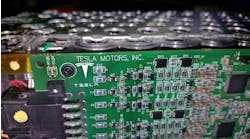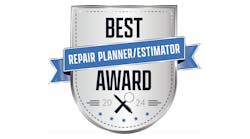“We’re going to need a new painter.”
Sharing that statement at your next management meeting will produce a variety of reactions and introspective observations. If you’re being left shorthanded in the immediate future because a painter is leaving, you’ll need to examine what happened and why someone felt the need to move on. If your business is growing and you need to expand your paint department, you’re looking at a challenge to go with some good news. In either case, you’ll need to act quickly. If your shop is small, you’re going to have to do something now, since you don’t want to fall behind on work and good painters don’t grow on trees.
Whatever your case, shops are well-served by having plans in place to regularly add painters. This is where your paint vendors can help. Not only can they offer you the best refinish solutions and products, but they can also provide you with valuable advice on finding the folks to use them.
What follows are five steps to create a ready supply of painters, using input from manufacturing training experts.
Step 1: Focus on building a bench.
Every paint company ABRN spoke to say the best option for accessing new painters is working from within your organization — promoting, training, and creating a pool of available or potential new painters who can step in when needed. Turning to an outside hire is difficult, since locating good collision repairers is big challenge and can mean “poaching” a painter from another shop, which isn’t going to win you any fans among your colleagues.
That’s not to say that finding a veteran painter from the outside doesn’t have certain benefits.
“An experienced technician from outside the business has already developed their foundational skill set and should be able to apply those skills immediately upon securing the position,” says BASF Training Manager Ralph Leija III. “Additionally, a skilled, experienced technician can assist with mentoring apprentices.”
Leija adds, “Shops should focus on developing or acquiring talent that will provide long-term opportunities and benefits and be sure to select an individual that will help grow and develop the business.”
Since growing and building your business should be your top priority, it only makes sense to have a workforce that will help you do both. Hiring from within provides you with a readily available source of painters and serves as a powerful incentive for your existing workforce to continue investing themselves in your operation. Says Chris Harsh, AkzoNobel Technical Instructor, “It creates a positive work environment where employees see that hard work and dedication is rewarded and there is opportunity to grow within the company.”
Hiring from within benefits you and your workforce.
Step 2: Begin to identify painter candidates.
Creating your bench begins with identifying staff interested in and capable of becoming quality painters. Start this process during your quarterly or annual employee reviews, which you need to be conducting.
“Shops should have yearly development plans for all employees to define their strengths and career expectations,” says Patrice Marcil, North American Learning & Development Director for Axalta. “It is important to build a team based on a mutual understanding of where everyone wants to be and/or how they are expected to contribute.”
Rod Habel, Director of Marketing for Sherwin-Williams Automotive Finishes, says it’s imperative for shops to use these reviews to advance the careers of employees, and movement to a paint position is just such of an advancement. “Look at your techs. If they can’t advance, they won’t stay. Your workers need to be able to move up or they’re going to move on,” he says.
Habel notes that painters can come from all parts of your operations — techs, preppers, detailers, and your administrative staff. Further, he suggests looking for that “diamond in the rough” — employees who may not stand out immediately as painting candidates but who would like to pursue this work.
Step 3: Find painters with the “right” qualities.
Years ago, there was something of a debate in the collision industry over whether painters were made or born, with some of the best-known owners in the market taking the latter position. The availability and effectiveness of training has since changed that thinking to the former. Still, considering the investment in time and resources needed for this role, you will want to look for specific traits in those wanting to be painters.
Gregg Whitmer, PPG curriculum development manager for Automotive Refinish, recommends assessing organizational skills and tidiness. “Are they messy? Do they keep their areas clean? Do they put away tools? Do they wear safety glasses and dust masks without having to be told? Technical skills can be taught, but they need these basic traits,” he says.
Harsh suggests looking for candidates with “a good eye for color, good application techniques, attention to detail, good decision making, and are teachable/willing to learn new things as well as having the patience to teach others.”
Some other traits you’ll want to identify are enthusiasm and a commitment to both quality and safety, says Habel. Place special emphasis on the ability to work within systems and follow technical processes. Leija declares, “The ideal candidate should have a proclivity to be pragmatic and systematic. These individuals should enjoy the technical aspects of refinishing and enjoy following the technical processes and procedures required to be successful.”
Step 4: Invest in the right training.
Once you have a candidate(s) in mind, you’ll need to start training. If you’re considering a prepper, you’ll already have someone with the necessary baseline of skills. If not, Whitner says these skills must be addressed first: “Start with basic skills such as cleaning and prepping areas to be refinished. Prepping new replacement parts. Basic sanding skills. Mixing paint. Some paint manufacturers offer in-person training for painter’s assistants.”
He and other manufacturers also strongly encouraged certification for new painters. Whitner notes, “Hands-on, in-person certification training is a complete course in any paint brand. It is great training and usually required for paint manufacturer warranties. Follow up with “recertification” training every two years (or as required).”
Before moving directly into certification, make sure all your candidates are firmly grounded in fundamentals. Harsh says plenty of veteran painters lack good fundamentals, so teaching them to new painters is a great time to reset your experienced paint staff as well. Fortunately, every paint company offers training in this area. A lot of it is available online, allowing your current and future paint staff to learn at optimal times when they don’t have to step away from work.
Finally, you’ll need to develop an effective training program. You don’t want to fly by the seat of your pants here and simply hold training when it is most convenient for you, especially if it’s based on guesswork about what a candidate needs. Work with the experts — trainers from your paint manufacturer and I-CAR who can put a program in place that ensures training touches all the necessary bases and is up to date. From there, impress upon your new painters the need for both ongoing training and staying up to date with industry developments.
Step 5: Determine when a new painter is qualified to work.
Knowing the right time for new painters to adopt their roles on their own might be your toughest chore. Putting trust in someone who has finished your training program isn’t enough. You’ll need to work with your managers and paint staff to advise you when a new painter is ready for full responsibility.
There are some factors you need to consider. AkzoNobel Technical Instructor Rob Haney says painters are ready once they have proven “they can refinish vehicles without redos, handle the amount of booth cycles the shop needs to produce, know the paint product system, and can manage the production flow while adjusting, improvising, and overcoming issues before they become problems.”
Whitner suggests having new painters specialize in an area like painting bumper covers for a while before blending color or spraying tri-coats so they may grow into the role over a period of time. “You don’t just flip a switch and they are ready to fly solo,” he says.
Whitner and Marcil agree that, ultimately, demonstrating ability matters most. “Doing something for a long period of time does not guarantee success,” says Marcil, adding, “You don’t necessarily measure experience in periods of time. It’s measured in skills learned and demonstrated proficiently. People do that at different rates.”
Bottom line — you’re going to need to keep a close eye on your new painters. That extra effort should pay off royally since you will have added necessary help and, in the process, grown your staff productively.
Developing new workers always is a challenge but can be done using a proper plan and the right direction. The product is well worth the effort. Building your business is a process built on getting the most out of the talents of your staff. You’re in a people business. Providing your team with opportunity will go a long way in ensuring their — and your — continuing success.


